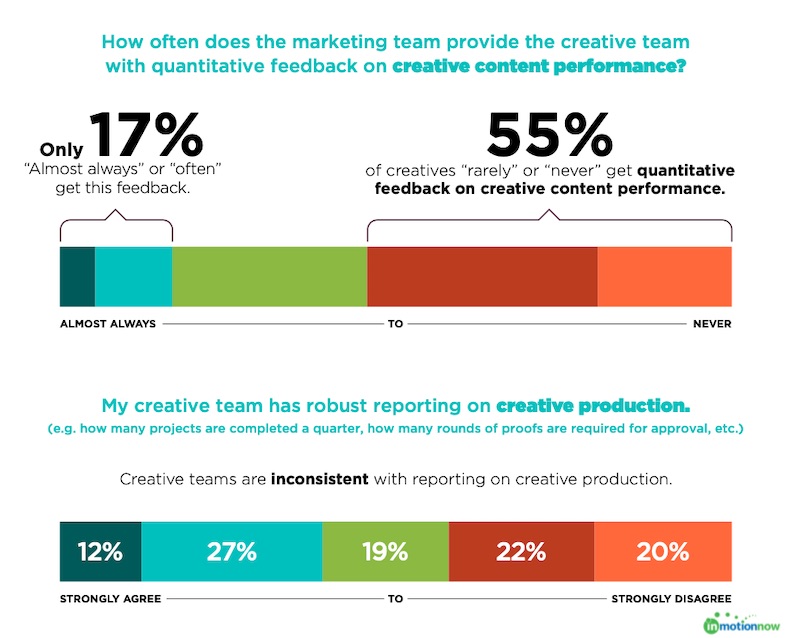"Mission-critical." That's how important it is for creative teams to receive both qualitative and quantitative feedback, according to senior marketing leaders, among them Helen Baptist.
She observed the issue firsthand as she progressed through the marketing ranks during her career. Today, she serves as the chief operating officer at PathFactory, where she is responsible for marketing, sales, and customer experience.
I believe she's right; and yet, there is a divide in many modern marketing departments.
As digital transformation has taken root, Marketing has developed an arsenal of key performance indicators (KPIs) to measure digital efforts. Those include metrics such as engagement, clicks, downloads, and user intent, among others.
More mature marketing departments take the measurement process a step further: They are capable of tracking and applying attribution techniques right down to the level of pipeline and sales.
So, where's the divide?
It emerges on the creative side of the house. Whether the creative team is an integral part of Marketing or operates as a separate team, talented professionals who visually and conceptually breathe life into marketing efforts are often flying blind.
In fact, 55% of creative content teams say they never receive quantitative feedback on how well an asset performed with customers and prospects, according to an annual survey my team conducts in collaboration with InSource.

In other words, the people CMOs rely on to do much of the heavy lifting—graphic designers and copywriters—never know whether their work is driving the desired outcome.
How to Give Creative Feedback: It Isn't 'I Don't Like Blue'
My thesis is that creative work performs best when it's aligned with marketing around business objectives. I believe including them in the measurement feedback loop is an important way to achieve that alignment. As a bit of a gut check on the notion, I posed that issue to several senior marketing leaders.
"Given the very nature of how marketing teams are measured—in terms of business outcomes, sales pipeline, and revenue—creative teams should be in the same feedback loop as teams working on- demand generation or product marketing," says Adam Kaiser, senior vice-president of marketing at OpenAsset.
Amy Barzdukas, chief marketing officer for WiTricity, agrees: "You need to be able to give feedback that isn't 'I don't like blue.'" She emphasizes that as quantitative measurement improves, marketing leaders need to find a way to include creative team members.
A common operating picture for measuring outcomes has upstream effects on the organization as well. It's the key to ensuring the team is working toward the same goals, according to Lacey Miller, head of marketing at LoudCrowd. She says creatives need to understand their impact on business results the same way an email marketer does, for example.
However, Lacey also readily acknowledges that is sometimes easier said than done because quantitative measurement isn't typically something that comes naturally to creative talent.
"Creative is tough because you are pushing them out of their comfort zone with quantitative measurement," she says. "But if creatives look around the organization, and everyone else has concrete numbers, and creatives don't, they can start to feel disconnected."
Five Tips for Including Creatives in the Quantitative Feedback Loop
Adam Kaiser notes there's a "direct impact" between "high-quality creative" and the performance of digital marketing. "The better the creative, the greater the results."
Measurement is the way to capture the data needed to improve creative content outcomes. Here are some tips marketing leaders offered for building a process to make that happen.
1. Help your team see what you see
Share what you are measuring with creative team members so they see what you see. That might sound obvious, but I'm surprised by how often it's overlooked.
One way to do so is to make metrics accessible to all team members, according to Adam. He requires metrics to be presented in every "team stand-up meeting," as well as a report on overall business performance, so the two are linked.
One way to make metrics accessible is through a collaborative self-service medium. Simple examples include an intranet, portal, or shared spreadsheet.
2. Think differently about teaching measurement to creatives
One of the benefits of having creative talent on your side is that creatives tend to think differently about marketing problems. Similarly, they absorb information and learn differently, too. That's an important consideration when designing a system to bring creatives into the quantitative feedback loop.
Amy Barzdukas recommends rethinking about how to best visualize data, and tapping the creative team for its expertise. For example, creatives help produce her presentations about marketing results to the company board. That interaction doubles as a professional development opportunity for her creative team.
"A creative who can visualize data will both be more analytical and becomes real talent to hang on to," she adds.
3. Gamify the testing of creative
A few of the marketing leaders I spoke with suggested involving creative teams in the design of tests—in addition to the act of testing. That drives a shared interest and a sense of ownership, and it presents a relationship-building opportunity between Creative and Marketing.
Measurement can be made to be fun, too. Amy noted she's had "good success with a weekly challenge on A/B testing" for "website and email drip campaigns." She challenges her teams to come up with a different test of copy or visuals every week. The team that wins the challenge earns a small reward, such as free coffee.
"Making it a challenge and making it playful gets the teams into the spirit of testing and thinking more analytically," she says.
4. Partner with revenue operations
Helen Baptist has found that operations departments—such as Marketing Operations or Revenue Operations—have proven invaluable in her organization for several reasons.
First, operations professionals bring a technical competency to bear. They are instrumental in procuring and implementing the right technology to measure success.
Second, Revenue Operations is adept at turning "quantitative results into visualizations that tell a story."
Operations also serves as an organizational diplomat of sorts, which helps check "egos at the door." Decision-making must be "balanced between quantitative feedback along with the voice-of-customer qualitative feedback."
"Pride in work is one thing; pride in delivering exceptional creative that drives business results is another," she says. "Revenue operations plays the role of 'Switzerland' in an unbiased, business manner."
5. Protect your creative team's time
Creativity doesn't happen with the click of a button. Creatives need space to be creative.
The same is true for measurement. Creatives need room to measure because, for many, it's a new and additional duty that can initially feel overwhelming.
One way to protect creative teams' time is to provide the right project management tools, according to Lacey Miller. She says creatives need to be equipped with automation and workflow so they can track projects in detail and easily report on progress to decision-makers.
"Make sure it's something public so they don't get sidetracked by that team that wants a random T-shirt," she adds.
Better still, perhaps, is that if those tools can both measure creative outputs and help loop performance data back to the creative team.
More Resources on How to Give Creative and Quantitative Feedback
Four Ways Marketers and Creatives Can Collaborate Better
Five Tips for Giving the Right Feedback on Web Design
Visual Design: Data-Driven Tactic or Qualitative Strategic Asset?




